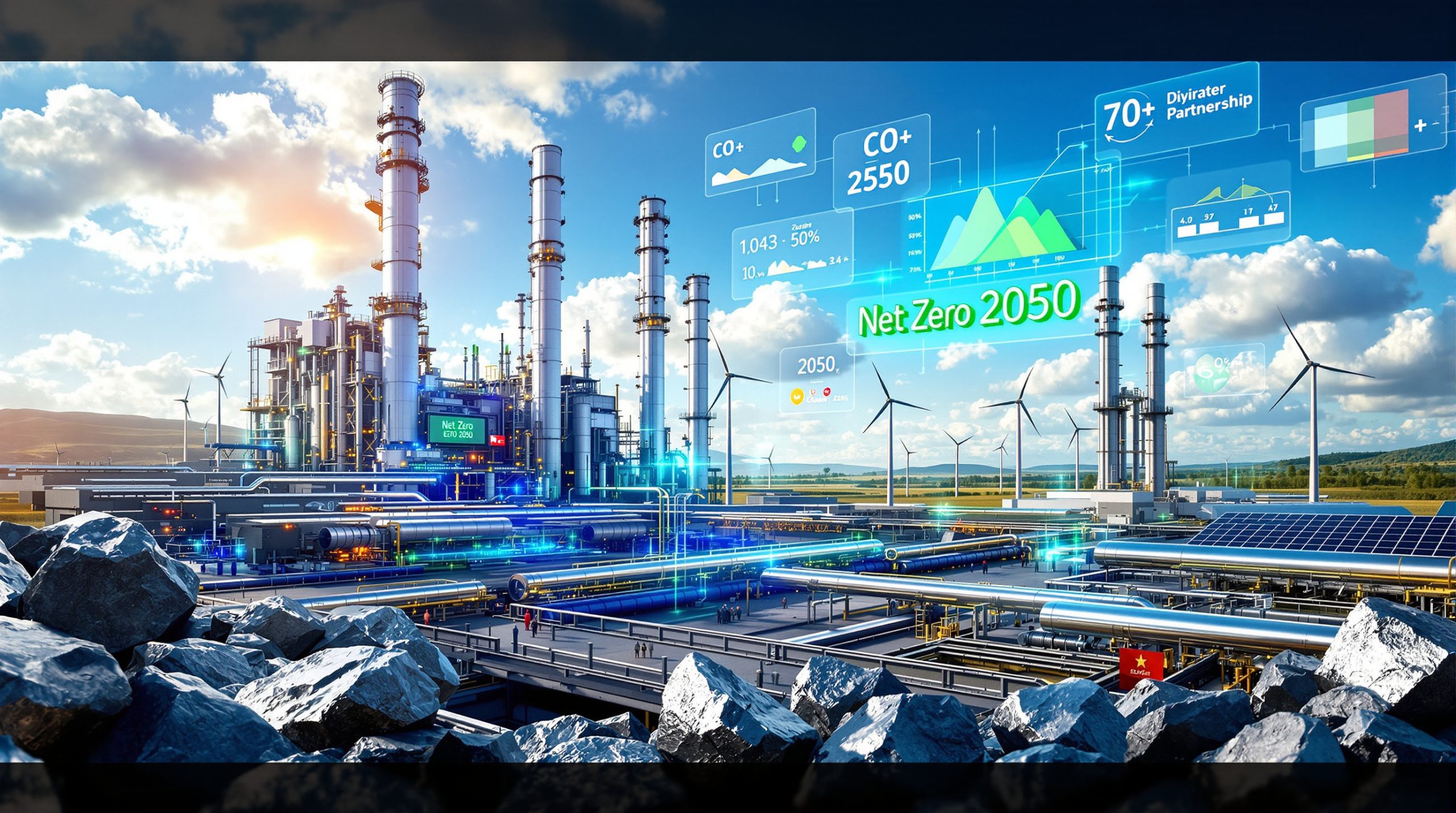Understanding Chile's Environmental Approval Framework
How Does Chile's Environmental Review Process Work?
Chile operates one of the world's most rigorous environmental assessment frameworks for mining projects, requiring comprehensive evaluation across multiple technical disciplines. Projects must undergo either a Declaration of Environmental Impact (DIA) or the more extensive Environmental Impact Assessment (EIA), depending on the scale and potential environmental significance of the proposed operations.
Marimaca Copper environmental approval represents a significant achievement within Chile's comprehensive regulatory framework. The project qualified for the DIA pathway by demonstrating that operations would not generate significant environmental impact across 17 distinct technical review categories. This classification reflects the project's relatively straightforward mining approach, conventional processing technology, and proactive environmental design considerations.
The DIA submission comprised over 4,000 pages of technical documentation, baseline environmental studies, and impact mitigation plans. This comprehensive package underwent evaluation by 17 separate government agencies, each examining the project through specialised regulatory lenses including water resource management, air quality protection, biodiversity conservation, archaeological preservation, and community impact assessment.
Chile's dual-pathway environmental assessment system allows regulatory authorities to allocate review resources proportionally to environmental risk. The DIA pathway, which Marimaca utilised, is designed for projects that do not generate significant environmental impact across established technical review categories. Furthermore, this determination is made during the screening phase based on project characteristics including geographic location, operational scale, technology maturity, and proximity to sensitive ecosystems.
Key factors that supported Marimaca's DIA classification include:
- Use of established heap leach technology with decades of operational precedent in Chile
- Location within an established mining region with existing infrastructure
- Straightforward open-pit mining approach with conventional ore handling
- Seawater utilisation eliminating freshwater competition concerns
- Proximity to port facilities reducing transportation infrastructure requirements
What Makes This Approval Timeline Significant?
The Marimaca Copper environmental approval was granted on February 28, 2025, representing approximately 11 months from formal submission. This timeline demonstrates exceptional efficiency within Chile's environmental review framework, which typically requires 18-24 months for completion. The expedited approval reflects several risk-reduction factors that distinguish successful projects from those experiencing regulatory delays.
The efficient timeline demonstrates Marimaca's strategic approach to regulatory engagement, working collaboratively with Chilean authorities rather than treating environmental review as a compliance exercise. CEO Hayden Locke noted that the approval represented the culmination of many months of work by the Marimaca team in collaboration with highly experienced Chilean environmental consultants. This collaborative methodology has positioned the company to advance toward construction-ready status more rapidly than many comparable development projects.
Several factors contributed to the streamlined approval process:
Technology Maturity: Heap leach solvent extraction-electrowinning (SX-EW) is an established technology with decades of operational precedent in Chile, reducing technical uncertainty in impact predictions. Neighbouring operations including Mantos Blancos and Lomas Bayas demonstrate long-term environmental compliance using similar processing methods.
Comprehensive Baseline Studies: Marimaca completed extensive environmental baseline work prior to DIA submission, including air quality monitoring, biodiversity assessments, archaeological surveys, and water resource evaluations. This proactive approach reduced the likelihood of requests for additional information during the review process.
Stakeholder Pre-engagement: The emphasis on collaboration with experienced Chilean consultants suggests structured pre-application engagement with government agencies, community representatives, and other stakeholders. This foundation reduced formal review delays and demonstrated regulatory competence.
Project Location Advantages: Proximity to established mining infrastructure and port facilities provided existing environmental baseline data and established operational frameworks, reducing the complexity of impact assessments.
Project Technical Overview and Environmental Design
What Are the Key Technical Characteristics of Marimaca's Operation?
The Marimaca Oxide Deposit is designed as an open-pit mining operation utilising conventional heap leach processing technology to produce approximately 50,000 tonnes of copper cathodes annually over a 13-year mine life. The operation will employ solvent extraction and electrowinning (SX-EW) processing, a proven technology widely used across Chile's copper industry.
| Operational Metric | Value |
|---|---|
| Annual copper cathode production | 50,000 tonnes |
| Mine life | 13 years |
| Processing method | Heap leach SX-EW |
| Strip ratio | 0.8:1 |
| Average copper recovery | 72% |
| Proven and probable reserves | 178.6 million tonnes at 0.42% Cu |
| Contained copper in reserves | 748,000 tonnes |
| Post-tax NPV (US$4.30/lb Cu) | US$709 million |
| Internal Rate of Return | 31% |
| Payback period | 2.5 years |
| Capital intensity | US$11,700 per tonne capacity |
| All-in sustaining costs | US$2.09 per pound |
The project's exceptional capital efficiency of US$11,700 per tonne of annual production capacity places it among the lowest-cost copper developments globally. This efficiency stems from the deposit's favourable characteristics including a low strip ratio of 0.8:1, conventional processing technology, and proximity to existing infrastructure. However, the 31% internal rate of return and 2.5-year payback period rank in the top quartile of development-stage copper projects worldwide.
Marimaca's metallurgical test work, spanning seven phases of column testing including 4-meter height columns, provides high confidence in the 72% average copper recovery assumption. This recovery rate aligns with industry standards for similar heap leach operations in Chile's Atacama Desert environment and reflects the deposit's favourable oxide mineralisation characteristics.
The operation's technical simplicity reduces execution risk compared to more complex concentrator-based developments. For instance, heap leach operations have proven track records in Chile, where several neighbouring operations including Mantos Blancos and Lomas Bayas have operated successfully for decades using similar processing methods and environmental management approaches.
How Does the Project Address Water Resource Challenges?
Water scarcity represents a critical consideration for mining operations in Chile's Atacama Desert, where annual precipitation averages less than 1 millimetre. Marimaca has addressed this challenge through an innovative water supply strategy centred on seawater utilisation rather than competing for limited freshwater resources.
The project will source water from Mejillones Bay, approximately 25 kilometres from the mine site, through a dedicated pipeline and pumping system. This seawater will undergo treatment and recycling throughout the heap leach process, with closed-loop circulation minimising overall consumption and eliminating discharge to the environment.
Seawater Strategy Advantages:
- Eliminates freshwater competition: No impact on local communities' water supplies or agricultural operations
- Proven technical feasibility: Neighbouring operations demonstrate successful seawater utilisation
- Environmental discharge elimination: Closed-loop design prevents process water release
- Regulatory alignment: Supports Chilean government priorities for sustainable water management
- Infrastructure proximity: Existing port facilities at Mejillones Bay provide established access
The innovative water approach involves several technical components:
- Seawater intake: Pumping system at Mejillones Bay with approximately 300+ metres elevation differential
- Initial treatment: Desalination and conditioning to remove marine organisms and optimise chemistry
- Process application: Direct use in heap leach solution circuits
- Recycling systems: Recovery and reuse of pregnant leach solution and barren solutions
- Closed-loop design: Minimal makeup water requirements after initial circuit filling
This comprehensive water management strategy positions Marimaca as an environmentally responsible operator while addressing one of the most significant operational challenges in Chile's mining sector. Additionally, the approach demonstrates technical innovation while supporting long-term operational sustainability.
Strategic Implications of Environmental Approval
What Development Activities Can Now Proceed?
The Marimaca Copper environmental approval enables the company to advance multiple critical workstreams toward a Final Investment Decision targeted for the second half of 2026. In addition, permitted activities now include detailed engineering design, long-lead equipment procurement, infrastructure development planning, and sectoral permit applications for specific construction activities.
Immediate Development Activities:
- Detailed engineering completion: Final design optimisation with Ausenco and NCL consulting partners
- Equipment procurement: Binding quotations for major processing equipment packages
- Infrastructure agreements: Power supply contracts with renewable energy providers
- Water supply finalisation: Agreements with Mejillones Bay authorities for seawater access
- Sectoral permitting: Construction safety certifications and utility connection permits
The company can now engage engineering contractors for final design optimisation, secure binding quotations for major equipment packages, finalise power supply agreements with renewable energy providers, and complete water supply infrastructure agreements with Mejillones Bay authorities. This parallel progression across multiple workstreams positions Marimaca to commence construction rapidly once financing is secured.
Remaining regulatory requirements include sectoral permits for specific construction activities such as road access approvals, utility connection permits, construction safety certifications, and transportation route authorisations. These sectoral permits are considered lower-risk than the primary environmental approval and typically require 3-6 months for completion.
Timeline to Final Investment Decision:
| Phase | Timeline | Key Activities |
|---|---|---|
| Q1-Q2 2026 | 6-9 months | Complete detailed engineering, secure sectoral permits |
| H2 2026 | 3-6 months | Final Investment Decision, construction financing |
| Q1 2027 | Construction start | Ground breaking, major equipment delivery |
| 2027-2028 | 18-24 months | Construction and commissioning |
| 2028-2029 | Production ramp | Full 50,000 tonne annual capacity |
How Does This Position Marimaca Competitively?
The environmental approval transforms Marimaca's competitive position within the global copper development pipeline by removing regulatory uncertainty and enabling advancement toward construction-ready status. This milestone is particularly significant given the scarcity of permitted, near-production copper projects globally.
Current market conditions favour permitted developers as copper price insights indicate trading above US$5.00 per pound on the London Metal Exchange, reflecting structural supply tightness that analysts project will persist through the decade. Consequently, Marimaca's ability to deliver meaningful production by 2027-2028 positions the company to participate in anticipated copper price appreciation driven by electrification and renewable energy deployment.
Competitive Advantages:
- Regulatory certainty: Completed environmental approval in major mining jurisdiction
- Proven economics: US$709 million NPV at conservative US$4.30/lb copper assumptions
- Capital efficiency: US$11,700/tonne places project in lowest global cost quartile
- Operating leverage: US$2.09/lb sustaining costs provide margin at current prices
- Infrastructure proximity: 25km to port facilities reduces logistical complexity
The approval also validates the company's technical approach and environmental stewardship, providing confidence for potential project financiers, strategic partners, and equipment suppliers. This regulatory certainty reduces execution risk and may improve financing terms for the approximately US$587 million in initial capital required for construction.
Marimaca's 88% resource-to-reserve conversion rate significantly exceeds typical industry conversion rates of 50-70%, demonstrating the deposit's geological certainty and reducing technical risk for potential financiers. This exceptional conversion reflects favourable metallurgical characteristics, simple geology, and conservative reserve classification accounting for operational contingencies.
Market Context and Investment Implications
Why Is Copper Market Timing Favourable for Marimaca?
Global copper markets face mounting supply pressures as energy transition initiatives accelerate demand while new mine development remains constrained. The International Energy Agency projects copper demand will double by 2040 driven by electric vehicle adoption, renewable energy infrastructure, and grid expansion requirements.
Simultaneously, copper mine development has stagnated due to declining ore grades, permitting challenges, and capital allocation constraints following the 2015-2016 commodity downturn. This supply-demand imbalance has created favourable conditions for permitted, near-production projects like Marimaca that can deliver meaningful output within the next 3-5 years.
Market Fundamentals Supporting Copper:
- Electric vehicle deployment: Each EV requires 2-3x copper content versus internal combustion vehicles
- Grid infrastructure expansion: Power transmission and distribution upgrades for renewable integration
- Renewable energy installations: Wind turbines and solar installations require significant copper content
- Energy storage systems: Battery installations and grid-scale storage development
- Industrial electrification: Manufacturing processes transitioning from fossil fuel power sources
Marimaca's project economics demonstrate resilience across copper price scenarios, with sensitivity analysis showing positive returns at prices as low as US$3.50 per pound while offering significant upside leverage at current price levels above US$5.00 per pound. This downside protection combined with substantial upside potential creates an attractive risk-reward profile for copper-focused investors.
Price Sensitivity Analysis:
| Copper Price | Post-tax NPV | IRR | Payback |
|---|---|---|---|
| US$3.50/lb | Positive economics | 18-22% | 3.5-4.0 years |
| US$4.30/lb | US$709 million | 31% | 2.5 years |
| US$5.00/lb | US$950+ million | 40%+ | <2.0 years |
What Are the Key Investment Catalysts and Risk Factors?
Near-term Catalysts:
- Final Investment Decision in H2 2026 removing construction uncertainty
- Project financing completion validating economics through third-party due diligence
- Construction commencement marking transition from developer to builder
- First copper production in 2027-2028 generating initial cash flows
- Exploration results from Pampa Medina sulphide targets providing growth optionality
Primary Risk Considerations:
- Construction capital requirements of approximately US$587 million requiring additional financing
- Copper price volatility affecting project returns despite favourable current levels
- Potential cost overruns or schedule delays during construction phase
- Chilean mining sector policy changes affecting taxes, royalties, or environmental regulations
- Operational risks including metallurgical recovery performance and equipment reliability
The company's current cash position of approximately US$77 million provides runway for pre-development activities but will require additional financing for construction through debt, equity, or streaming arrangements. Management is exploring various capital structures including project debt, equipment financing, streaming agreements, and potential strategic partnerships to optimise financing costs and maintain shareholder value.
Investment Risk Mitigation Factors:
- Extensive technical work: Seven phases of metallurgical testing and detailed feasibility studies
- Proven technology: Conventional heap leach processing with established operational precedent
- Chilean jurisdiction: Stable regulatory environment with established mining law framework
- Infrastructure proximity: Access to skilled labour, experienced contractors, and supply chains
- Conservative assumptions: Feasibility study based on US$4.30/lb copper versus current US$5.00+ prices
Exploration Upside and Long-term Growth Potential
What Additional Opportunities Exist Beyond the Oxide Deposit?
Marimaca controls a district-scale land position in Chile's Coastal Copper Belt, providing significant exploration upside beyond the permitted oxide operation. The Pampa Medina sulphide target, located 25 kilometres from the planned processing facilities, has demonstrated compelling drill results that could transform the company's long-term production profile.
Notable Pampa Medina Intersections:
- 100 metres at 1.3% copper from 580 metres depth
- 26 metres at 4.1% copper within the broader intercept
- 6 metres at 12.0% copper in high-grade zones
- Consistent mineralisation over substantial vertical intervals
- Proximity to existing infrastructure reducing development costs
The 6 metres at 12.0% copper intersection represents exceptional grade mineralisation that could support high-margin production if successfully expanded through additional drilling. These results indicate potential for significant additional resources that could support future production expansions leveraging the oxide project's processing infrastructure.
Successful resource definition at Pampa Medina could support several development scenarios:
- Satellite oxide deposits: Additional heap leach feed extending mine life beyond 13 years
- Sulphide processing expansion: Concentrator development for higher-grade sulphide ores
- District-scale operations: Multiple production centres connected by shared infrastructure
- Exploration optionality: Systematic exploration across broader land package
The company is currently executing a 10,000-metre drilling program at Pampa Medina, with results anticipated through 2025-2026. This exploration work proceeds in parallel with oxide development, reflecting management's strategy to build long-term production capacity rather than limiting operations to the initial oxide deposit.
District-Scale Potential:
Marimaca's consolidated land position includes three key properties: the flagship Marimaca Oxide Deposit, the Pampa Medina exploration target, and the Madrugador acquisition. This district-scale approach provides both geological diversification and infrastructure synergies that could support multi-decade operations in one of the world's premier copper-producing regions.
The Coastal Copper Belt's geological characteristics suggest potential for additional discoveries across Marimaca's land package. Historical mining in the region demonstrates long-term copper endowment, while modern exploration techniques may identify previously unrecognised mineralisation systems.
Management Strategy and Execution Track Record
How Has Management Navigated the Development Process?
CEO and President Hayden Locke brings nearly 20 years of experience in mining and finance to Marimaca's development strategy, including previous roles as Head of Corporate Development for Papillon Resources and CEO of Emmerson Plc. This background provides direct experience navigating companies through the critical development phase from exploration to production.
Under Locke's leadership, Marimaca has systematically de-risked the project through comprehensive technical studies, proactive stakeholder engagement, and strategic regulatory advancement. The company's approach emphasises collaboration with experienced Chilean consultants rather than attempting to navigate complex regulatory environments independently.
Management Execution Highlights:
- Environmental approval within 11 months of submission demonstrating regulatory competence
- 88% resource-to-reserve conversion rate exceeding industry norms through technical execution
- First-quartile capital intensity at US$11,700 per tonne of production capacity
- Strategic consultant partnerships with experienced Chilean environmental and engineering firms
- Successful capital raising of A$80 million providing financial runway for development
This collaborative methodology has yielded measurable results across multiple development workstreams. Furthermore, the emphasis on working with highly experienced Chilean environmental consultants reflects risk mitigation rather than cost minimisation, prioritising execution certainty over short-term savings.
Locke's statement regarding the environmental approval emphasised both the collaborative approach and systematic execution: the approval represented the culmination of many months of work by the Marimaca team working with highly experienced Chilean environmental consultants. This perspective demonstrates management's focus on building institutional relationships rather than treating regulatory compliance as a transactional process.
What Is the Timeline to Production?
Marimaca's development timeline targets first copper production in 2027-2028, following a Final Investment Decision in the second half of 2026. This schedule assumes successful completion of project financing, detailed engineering work, and sectoral permit acquisition over the next 12-18 months.
Development Milestones:
- Q1-Q2 2026: Complete detailed engineering and secure sectoral permits
- H2 2026: Final Investment Decision and construction financing
- Q1 2027: Construction commencement and major equipment delivery
- 2027-2028: Construction completion and first copper cathode production
- 2028-2029: Production ramp-up to full 50,000 tonne annual capacity
This timeline positions Marimaca to enter production during anticipated copper supply deficits as global electrification accelerates while new mine development remains constrained. The company's location in Chile's established mining region provides access to skilled labour, experienced contractors, and proven supply chains, reducing execution risks compared to frontier jurisdictions.
Construction Phase Planning:
The construction timeline reflects the project's operational simplicity and infrastructure advantages. Heap leach operations require less complex processing facilities compared to concentrator-based developments, while proximity to port facilities and existing mining operations provides established logistics and supply chain access.
Major construction activities will include open-pit development, heap leach pad construction, processing facility installation, water supply infrastructure development, and power transmission connections. The modular nature of heap leach operations allows for phased commissioning, potentially enabling early production while completing final construction phases.
Investment Analysis: Positioning for Copper's Structural Bull Market
Marimaca Copper environmental approval represents a transformative milestone that removes regulatory uncertainty and positions the company as a permitted developer in Chile's premier copper-producing region. The combination of proven reserves, robust project economics, innovative environmental design, and strong copper market fundamentals creates a compelling investment proposition for exposure to copper's structural supply-demand imbalance.
The project's technical characteristics including industry-leading capital efficiency, first-quartile operating costs, and proven heap leach technology reduce execution risks while providing leverage to copper price appreciation. With regulatory certainty now established and a clear pathway to production by 2027-2028, investors can evaluate Marimaca based on construction execution and project financing rather than permitting uncertainty.
Investment Considerations:
- Environmental approval removes key development uncertainty in established mining jurisdiction
- US$11,700 per tonne production capacity ranks among lowest globally for copper developments
- 50,000 tonne annual production captures structural market tightness in critical commodity
- 31% IRR and 2.5-year payback support rapid capital return post-production
- Pampa Medina sulphides offer 50-100% production upside through exploration success
- US$77 million cash position supports pre-development without immediate dilution concerns
For mining-focused portfolios, Marimaca offers leveraged exposure to copper's indispensability in electrification, grid expansion, and renewable energy deployment trends that appear structural rather than cyclical. The company's district-scale exploration upside at Pampa Medina provides additional optionality for long-term production growth, potentially transforming a 13-year oxide operation into a multi-decade copper producer.
Risk-Reward Assessment:
The investment case balances significant upside potential against identifiable development risks. Construction capital requirements of US$587 million represent the primary financing challenge, while copper price volatility could affect returns despite favourable current market conditions. However, extensive technical work, proven processing technology, and Chilean jurisdictional advantages mitigate operational execution risks.
The mining industry evolution demonstrates increasing focus on sustainability and efficiency, areas where Marimaca excels. The project's seawater utilisation strategy aligns with mining decarbonisation benefits, positioning it favourably within evolving industry standards.
Marimaca's 88% resource-to-reserve conversion rate and comprehensive metallurgical testing provide technical confidence, while the company's collaborative approach to regulatory advancement demonstrates management competence in critical development phases. The environmental approval milestone validates this systematic risk reduction strategy and positions the company for construction-phase execution.
As gold & copper exploration continues to gain importance in resource development, Marimaca's permitted status provides a significant competitive advantage. The mining permitting insights suggest that successful navigation of regulatory frameworks becomes increasingly valuable for developers.
As global copper supply constraints intensify and energy transition investments accelerate, Marimaca's permitted development status and proven project economics position it to capitalise on favourable market dynamics through the remainder of the decade. The combination of near-term production catalysts and longer-term exploration optionality creates multiple pathways for value creation in an increasingly copper-constrained world.
Ready to Identify the Next High-Potential Mining Opportunity?
Discovery Alert's proprietary Discovery IQ model delivers instant notifications on significant ASX mineral discoveries, empowering investors to capitalise on actionable opportunities ahead of the broader market. With Marimaca's environmental approval highlighting how permitted projects gain competitive advantages, discover why major mineral discoveries can lead to exceptional market returns and begin your 30-day free trial today to position yourself at the forefront of mining investment opportunities.




